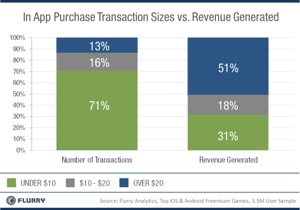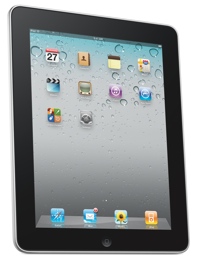Digital distribution of games is disrupting the retail portable game category. At the heart of this disruption is the proliferation of iOS and Android devices, which is doubling as a powerful portable gaming platform and challenging Nintendo DS and Sony PSP for gamer mindshare, according to the folks at Flurry (http://www.flurry.com), a mobile application analytics and recommendation-engine company.
Now if only my dream of having the ability to “upsize” iOS games for the Mac would come true.
In previous reports (2008 – 2009, 2009 – 2010), Flurry measured that iOS’s and Android’s revenue share of the U.S. portable game software category exploded to 34% in 2010 from just 1% in 2008. Over this same time period, the company calculated that Nintendo’s U.S. portable game revenue share contracted to 57% from 75%.
All the while, Nintendo chief executive, Satoru Iwata, has remained outspoken, calling smartphone games worthless and warning the gaming industry of boring consumers. In contrast, Wedbush Morgan Securities veteran video game analyst, Michael Pachter, stated in April 2011 that “Nintendo will have to share the market with Apple and Android” because “the onslaught of $1 games is going to continue.” By Flurry’s calculations, the onslaught is now coming in at a crushing $14 per transaction and from within the Trojan horse of freemium (a.k.a. free-to-play) games.
A new report builds on analysis released earlier this month, when Flurry revealed that games drive 75% of revenue generated among the top 100 grossing iOS apps, of which 65% were generated from freemium games. In the enclosed chart, we look at how 3.5 million consumers spent their money across top iOS and Android freemium games.
The left-hand column shows the distribution of transaction sizes within freemium games; in other words, how many times consumers spent anywhere from US$0.99 to sometimes over $100 per transaction. Each purchase equates to a virtual good or currency in the game a consumer is playing.
Flurry organizes the data into three price buckets: under $10; from $10 – $20; and over $20. You’ll see 71% of all transactions are for amounts under $10, 16% are for spends between $10 to $20 and 13% are for amounts greater than $20. The average amount spent per transaction is $14.
Let’s spend a moment on the $14 average, which may seem high at first. There are two reasons the average settles here. First, within the “under $10” bucket, most transactions cluster at the $9.99 level, followed by $4.99, and finally $0.99. In fact, in total, consumers spent $0.99 less than 2% of the time. Why then would so few consumers spend just $1 in freemium games when this price point is so popular among premium games (the pay-before-you-can-play model)?
Because freemium games drive a different decision-making mindset for consumers. They simply are deciding whether or not to spend. Our data shows that around 3% of consumers will spend money in freemium games. A deep commitment to the game experience appears to influence their buying habits.
The second reason the $14 average seems high is because the high-end of the spending spectrum is very high. Among all purchase price points, over 5% of all purchases are for amounts greater than $50, which rivals the amount paid at retail for top console and computer games.
Now, let’s look at the amount of total revenue generated per price bucket. Scanning this column from Flurry, we see the amount of revenue generated per price bucket is flipped in comparison to the price points at which the bulk of transactions occur.
On the low end, we’re “packing sardines” — that is, accumulating a lot of small transactions. While the under $10 bucket delivers about two-thirds of the transactions, it only accounts for about one third of the dollars. On the other end of the spectrum, at the “over $20” spend-level, we find the “whales.”
In fact, further breaking down the “over $20” category, 30% of the total revenue is generated from transaction sizes of over $50. If you’re a game designer, your main take away is that very few transactions — and consumers who complete those transactions — make up the bulk of your revenue. Therefore, your “meta-game” should be about whale hunting.
By the end of 2011, Flurry estimates that total U.S. iOS and Android game revenue will surpass $1 billion. Digital distribution has already affected notable media & entertainment industries including film, newspaper, television, music and books. The video game industry is no exception, with portable gaming already feeling the impact.
Now imagine mobile games — freemium and otherwise — taken to the next level with, as I’ve mentioned before, the GameDock system proposed by “Mac/Life” (though I’d put a twist on it): “The GameDock accommodates the iPhone and iPod touch and hooks directly to your TV and the Internet. Whether you download a game wirelessly via the handheld or wiredly via the GameDock, you pay just once for two versions of the same title.
“This is where things get interesting. When you download a game straight to your handheld, you can immediately begin playing the touch-controlled version of the game. And it’s glorious! And the next time you seat your handheld in the GameDock, the console immediately sucks down the full, expanded version of the game from the App Store, and stores it in its voluminous hard drive.
“So now you can play the console version of the very same game — with more features, more content, expanded controls, and, thanks to the GameDock’s integrated graphics processor, better visuals.
“And should you first download a game when your handheld is seated in the GameDock, the ‘mini’ version of the game shoots straight into your iPhone or touch, ready to play the next time you disengage from the console and hit the road.
“Of course, the GameDock scheme wouldn’t be quite so interesting if not for its seamless integration of content. For some game titles, the handheld version of the game exists as sort of an autonomous ‘mini game’ — its gameplay model runs independent of the console version’s. But for other titles, the handheld and console versions of the same game work together. Gameplay models obviously differ between the mobile and full versions, but each version hooks into the other in creative, novel, symbiotic ways. And through the power of syncing, your progress in level- and achievement-based games is saved and always propelled forward, regardless of which version you’re playing.”
But let’s take it even farther, as I’ve proposed before. What if Apple used the GameDock as a way to sell more Macs by offering Mac-only gaming options that tie in with the iPhone and iPod touch? Instead of connecting to a TV, the GameDock would connect to a Mac (and perhaps be built into high-end iMacs), allowing Apple computers to run the “bigger” versions of the “mini” games on the iPhone and iPod touch that Mac|Life suggested. The GameDock would also allow gyroscopic, multi-touch, accelerometer-equipped game controls (made by Apple, natch) to be used with the Mac games.
— Dennis Sellers




